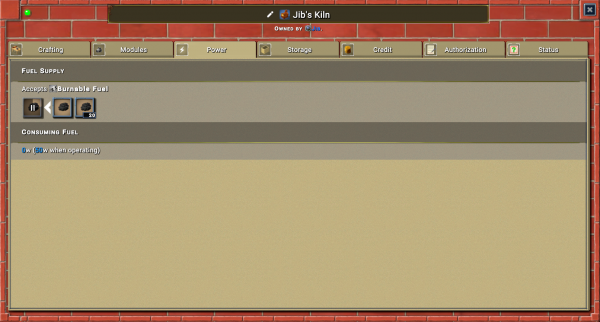Power: Difference between revisions
| [checked revision] | [checked revision] |
No edit summary Tag: 2017 source edit |
Tag: 2017 source edit |
||
| Line 95: | Line 95: | ||
Mechanical power is supplied through: | Mechanical power is supplied through: | ||
* [[Waterwheel]] - 20W | |||
* [[Windmill]] - 20W | |||
* [[Steam Engine]] - 2000W | |||
There are several [[:Category:Consumers of mechanical power|consumers of mechanical power]]. | There are several [[:Category:Consumers of mechanical power|consumers of mechanical power]]. | ||
| Line 116: | Line 104: | ||
It does not appear to matter if the objects are attached to a deed. | It does not appear to matter if the objects are attached to a deed. | ||
==Electric Power== | ==Electric Power== | ||
There are two types of electric objects in-game: supply objects and demand objects. | There are two types of electric objects in-game: supply objects and demand objects. | ||
Revision as of 08:53, 25 June 2024

Power is needed to operate more advanced crafting stations in Eco. There are three types of power: Fuel, mechanical, electric power.
The "Power" tab of an object will show the type and amount of power that is needed or generated.
Electric and mechanical power are measured in watts (W). Fuel power is measured in Joules (J).
Fuel Power
Early crafting stations, such as the Campfire, require fuel to function. The fuels accepted by each crafting station are visible under the "Power" tab.
Each fuel-powered crafting station has one inventory space for fuel currently being consumed, and two inventory spaces for fuel reserves. Only one unit of fuel can be burned at a time, but fuel reserves can accept stacks of fuel up to that item's stack limit.
Fuel reserves will appear in linked storage, allowing them to be the destination for crafting projects that create fuel items.
Fuel Types
A fuel source is any fuel that can be used in the fuel supply of the Power Tab.
There are several consumers of fuel.
| Item | Energy | Weight | Stack limit | Stack Energy |
|---|---|---|---|---|
| 80,000J | 11.00kg | 20 | 1,600,000J | |
| 20,000J | 1.00kg | 100 | 2,000,000J | |
| 4,000J | 10.00kg | 20 | 80,000J | |
| 4,000J | 10.00kg | 20 | 80,000J | |
| 500J | 0.01kg | 100 | 50,000J | |
| 2,000J | 0.50kg | 100 | 200,000J | |
| 80,000J | 30.00kg | 10 | 800,000J | |
| 80,000J | 30.00kg | 10 | 800,000J | |
| 1,000J | 0.50kg | 1 | 1,000J | |
| 2,000J | 0.02kg | 100 | 200,000J | |
| 4,000J | 0.10kg | 100 | 400,000J |
Fuel notes
Server configurations allow server owners to change the energy values for the different fuels. Servers can modify these values or add/remove fuel types. Consult with your local server admin for accurate fuels.
Recent testing as of Beta 0.7.2 (staging) suggests that either energy contents of fuels are half of what the given info really is, or that stations burn through the fuel twice as fast. Needs further testing.
Mechanical Power
Mechanical power is supplied through:
- Waterwheel - 20W
- Windmill - 20W
- Steam Engine - 2000W
There are several consumers of mechanical power.
To operate, the Windmill or Waterwheel must be placed within close range (~34 blocks) of the object to be powered. If two power sources are placed within ~60 blocks of each other, they create a power grid, giving access to all power on the grid to any table within 34 blocks of any sources in the grid.
It does not appear to matter if the objects are attached to a deed.
Electric Power
There are two types of electric objects in-game: supply objects and demand objects.
Supply Objects
Supply objects broadcast power in an area 40 blocks from their origin. This creates a "grid" of power that demand objects can draw from. The power grid appears to be unaffected by property claims.
When placing a supply object, the primary block it is placed on is the center of its power radius. This also applies to larger objects such as Solar Generators.
Within any grid, all supply objects will add their wattage to a combined total, and all demand objects will drain from the total.
Transmission Poles can be placed to extend the range of the power.
Supply objects include: Template:IconFrame Template:IconFrame Template:IconFrame Template:IconFrame
Demand Objects
There are several consumers of electric power.
Demand objects will subtract wattage from the grid based on their power demand. Demand objects also broadcast power, but only at a distance of 20 blocks from the object.
Although demand objects do not generate power, this means that the radius of a power grid can be expanded by placing a demand object at the edge of a supply object's power radius.
All electronic objects (supply and demand) will link together and become part of the same grid, even if they are offline. Once linked to the grid, an object will remain connected until all supply objects are removed from the grid. If all connecting objects between a supply object and a demand object are removed, the demand object will remain powered, even on the opposite side of the world!